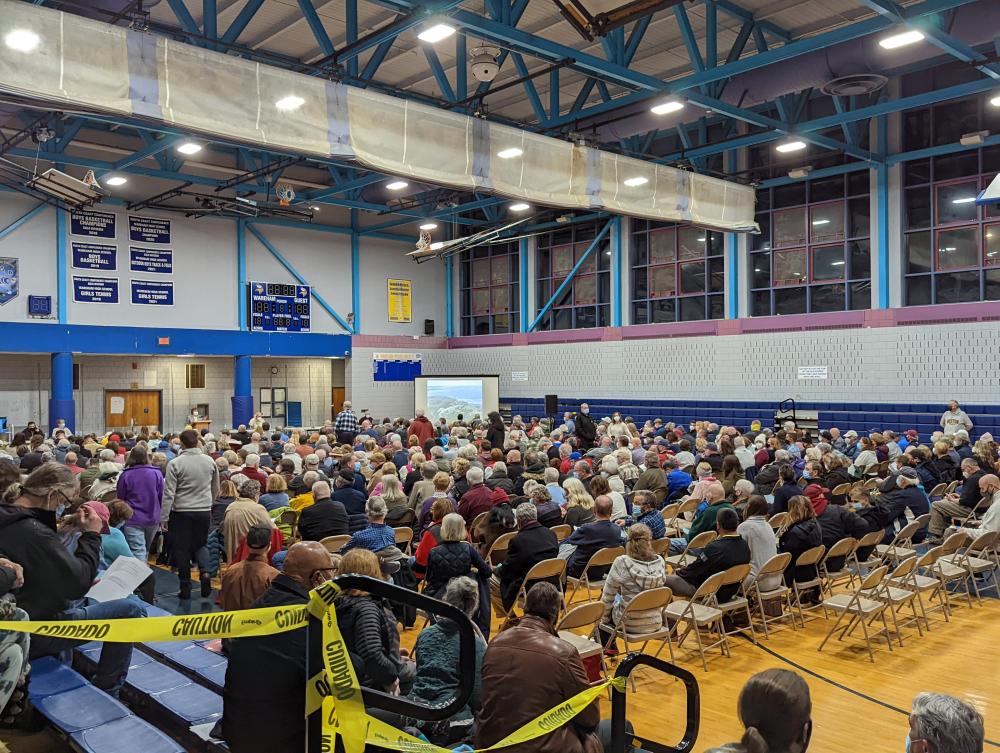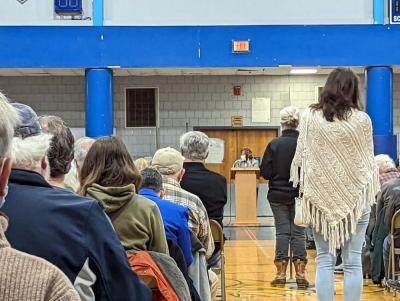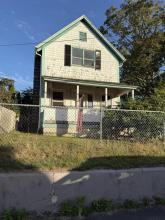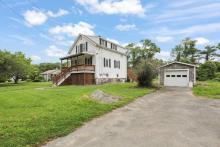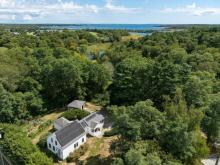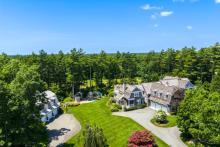Landslide vote secures town’s purchase of Little Harbor golf course
Hundreds of Wareham voters gathered at the high school Tuesday night for a special Town Meeting — and 423 of them agreed that the town should buy the Little Harbor Country Club, with only 34 voting against the purchase.
At 7 p.m. when the meeting was slated to begin, the line to check in still snaked down a hallway and out the front door of the school.
While there was some debate about the financial feasibility of the purchase and whether or not the golf course should be maintained, an overwhelming majority of voters were ultimately in favor of the purchase.
Town Moderator Claire Smith announced before the meeting began that the night’s two items would be combined, marrying the request to purchase Little Harbor Golf Course with the request to use Community Preservation funds. Prior to the night’s meeting, the two warrant articles were distinct, with the understanding they would be voted on separately.
The first article asked voters to approve a $2.3 million price for the purchase of the club and an additional $300,000 for related costs. The second article asked voters to approve the use of $2 million in Community Preservation money to fund the purchase of the land — a move that required the permanent preservation of the land as open space. Community Preservation funds are collected through a surcharge on property taxes and are restricted for certain purposes. Using the funds for this purchase will not change the tax rate, Select Board chair Judith Whiteside said.
The 54-acre course had been on the market for some time, and after a potential deal with Mass Audubon fell through last summer after pushback from golfers and town officials, the course’s owners began closed-door negotiations with the Select Board. Just after the new year, officials first pitched the idea to voters. A special Town Meeting was scheduled to bring the purchase before voters for approval by the end of February, which is when the owners said they’d need a final answer from the town.
Kathy Pappalardo, the president of the Wareham Land Trust, spoke in favor of the purchase.
The Land Trust is in talks with the town about holding the conservation restriction on the land. That means they’d be responsible for its stewardship in perpetuity: “Golf for now, open space forever,” she said.
She said that even while the land is being used for golf, it still holds conservation value that development would not.
“Protecting these 54 acres from development allows for continued public access, the potential for future walking trails, all-person accessible trails, benefits the quality of the bay, allows for salt marsh migration, flood control, protects existing wetlands and forests and maintains wildlife corridors and natural habitats,” Pappalardo said.
Linda Rinta spoke in favor of the purchase, and pointed out despite some voters’ concerns that the course would end up costing the town too much money, it has been a self-sufficient business for nearly 60 years. Her grandfather farmed the land before that. After several hurricanes that flooded much of the land meant that farming was no longer feasible, he decided to pursue something new.
“Together with his neighbors [he] decided to build the golf course for the stated purpose of holding the land in open space and providing instead for outside, outdoor recreation,” Rinta said.
Some voters expressed skepticism — one man said that the continued operation of a golf course was counter to conservation goals, and one warned against the temptation to act emotionally, warning, “When I think with my heart, all I get is heartburn.”
Finance Committee member Joey Smith said he had mixed feelings about the course’s purchase, especially as he used to work as the superintendent for a municipal golf course.
Joey Smith said when the Finance Committee met to discuss the purchase, they were not provided with sufficient information about the business’ finances to make an informed decision. He was one of three Finance Committee votes recommending against the purchase.
He called the course’s equipment questionable, and said he wasn’t sure how good the course’s irrigation systems are.
But as a resident, Joey Smith said he liked the idea of the course, and the number of available properties close to the bay are declining.
“It’s a great golf course,” he said as he conceded that Town Meeting has the ultimate say. “This party will make the final decision.”
Several residents shared the opinion that not enough information about how the purchase would be made, what would happen if the course is not profitable or how the land would be used if the course is not profitable was shared prior to the town’s vote.
Other residents brought up concerns they had about other town issues they felt were better uses of available funds.
One Onset resident said he loves open space, but certain areas of Wareham need the money more.
“Wareham Ave. is a slum,” he said. “It’s a disgrace to be in Onset.”
Whiteside acknowledged the validity of those concerns, but explained community preservation funds are limited in what they can be used for. The funds can’t be used for items like potholes, snow plows or better lighting — they’re reserved for historic preservation, open space, recreation and affordable housing.
This project will withdraw money from the open space and recreation funds within community preservation’s wider budget, Whiteside said.
Not everyone who wanted to speak about the purchase had the chance to. As a few final residents were lined up at the microphone to share their opinions, Select Board member Alan Slavin made a motion to “move the question” — which would cut off debate and force voters to decide immediately. That motion was voted on by the crowd, who by a large majority were ready to decide whether to buy the course.
This frustrated several residents, both those waiting in line to speak who cried out asking for their chance to talk and others in the crowd asking the moderator why those in line couldn’t go first. But the crowd prevailed.
When Claire Smith asked those in favor to cast their votes, hundreds of hands raised their blue slips in agreement — the town should buy the 54 acres.



